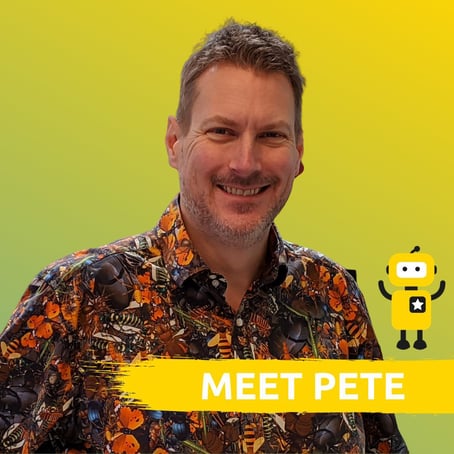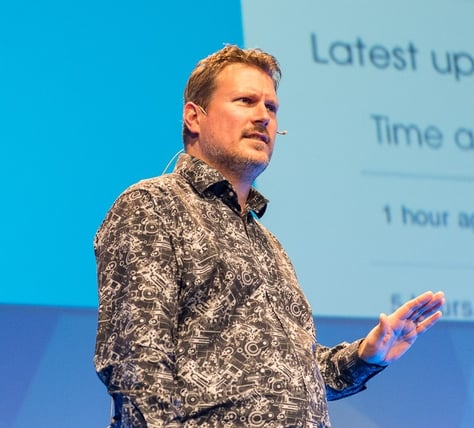
Let’s play! Time to gamify your marketing campaigns in 2022
We’re seeing the term ‘gamification’ being used a lot more in marketing these days. It’s the application of traditional gaming methods in non-context environments - and it’s everywhere! So, we thought it was time to take it to The Big Bright Podcast.
In this episode, we invited Pete Jenkins to chat about all things gamification. Pete is the international authority on gamification. He's a lifelong gamer, successful entrepreneur, a lecturer and CEO of Gamification+. He mentors and trains companies worldwide on the use of gamification to solve business challenges.
We discuss how you can use gamification in your marketing campaigns, how it can help build brand awareness and how you can kick off your very own gamification project. We’ll also hear Pete’s predictions for gamification in 2022!
You can listen to the full episode via Spotify, Apple Podcasts or Vurbl Media. Or, take a read of the summary below.
Sit back and read on to discover:
The true definition of gamification
How Pete’s passion for gamification ignited
Typical elements of gamification
How can you build brand awareness through gamification?
How to start your own gamification project?
The future of gamification as predicted by Pete
And finally…
A 25% discount for Gamification Europe
The true definition of gamification
In its simplest form, gamification quite literally means to ‘gamify’ something. That is, using gaming methods and implementing them on websites, marketing campaigns, software products and more. Ever signed up to new software and prompted to complete a series of tasks? You’ve been gamified!
Pete uses the definition by Keith Werbach.
“Gamification is the process of making activities more game - like.”
Nicely put! This gives us an instruction - it tells us what we need to do next to kick off the gamification aspect of our campaigns.
How Pete’s passion for gamification ignited

For Pete, it all started when he was running an IT company. He was using CRM databases mostly.
“We were working with big complicated bits of software that staff members didn't necessarily use that much. If you want someone to use a piece of software, they need to be using it and benefiting from it. Bigger businesses can do things like pay for regular training of their staff, and that keeps things fresh in the mind. But for those people without a budget or a much lower budget, what do you do?”
After learning about UX he realised that there was one answer. Games. He quickly moved to a gamified CRM and saw that staff were adopting it quicker and therefore engaging better with customers, reporting and generally having a better time with the system.
Typical elements of gamification
Gamification is often used to teach people something new. It’s a way of helping people develop a new skill so they can better use a system or learn about a new product or service. Typical gamification mechanics include rewards such as points, leader boards, badges and mission progress. Pete says the more that someone learns and uses a gamified system, the less the gamification elements will appear.
“For instance, in a CRM, you're potentially making people do an extra click or two in order to engage with the game mechanics as well as do their job. So that's good in the beginning because it's engaging them and making them actually complete the stuff and learn it. But eventually, it's just going to get in the way.”
Knowing when to stop is often just as important as knowing when to start.
How can you build brand awareness through gamification?
So, for marketers, how can we begin using the typical elements of gamification in our campaigns? Pete suggests we should be using it for brand awareness and takes it back to the idea of brand loyalty. He starts by giving an example of where gamification doesn’t work so much anymore.
“As an example, what we're starting to see is typical loyalty programs having trouble actually maintaining loyalty. Most loyalty programs have points that you collect over time. But it's not really enough anymore.
One reason is that people are used to them. When I'm running a workshop, I often ask people in the audience what loyalty cards they have. They don't just have one. They’ve got one for each of the chains that they're shopping at which means that they're not really loyal at all. It defeats the point.”
One of the challenges that Pete has been tackling is maintaining customer loyalty. He says the answer is building an experience around your brand.
“You need something that reminds the customer of your brand at a particular point so that you are front of mind when the important purchasing decision actually happens. That's where gamification can be really useful.”
Check out the full podcast episode to listen to Pete’s real-world examples including Nike, British Heart Foundation and Santander.
How to start your own gamification project?
If you’re interested in kicking off your own gamification project, Pete suggests to simply start playing games.
“The secret to it really is to play some games. Play a broad range. Choose some games you wouldn't normally play and the types you wouldn't because then you'll get a better understanding of what your target audience might play. And then try and just build something fun, but something very small.”
You could start by introducing games at your next B2B event or do something interesting with your business card.
“I always like to get my new members of staff to gamify their business card, so they all have to think of something different. One person created a scratch card. If you wanted the phone number or the email address, you have to scratch it off. A simple bit of engagement.”
One key thing Pete says to remember is to never start with a game in mind. “You have to go through a process of understanding what your audience wants.” This doesn’t mean shoe-horning your favourite game into a marketing campaign.
The future of gamification as predicted by Pete

Pete is the expert, so we asked him what he thinks the future of gamification looks like for 2022 and beyond. Here are his top three:
- “Gamification is often about borrowing or being inspired by what works really well in the games industry. It tells us what's going to happen next in gamification. So the big thing we can see is machine learning and AI helping us build personalised journeys for each customer or player so that people actually get the experience just tailored for them. Everyone likes different elements of games. That's happening in the big games and that will have to happen in gamification as well.
- Another thing I think works really well with gamification is immersion. So we can see more people immersing themselves in the content and the story. I'm not a big fan of buzzwords, but I guess the metaverse is going to have an impact.
- “Lastly, gamification is broadening out into different industries it sits in. It started off, funnily enough, in marketing and finance. Now you see it across everything from sustainability, health, learning and almost every aspect of the employee experience has got gamification platforms or possibilities now.”
Gamification Europe 2022 discount
If you’re interested in learning more about gamification, you can grab 25% off Gamification Europe which takes place in March 2022. This is the biggest gamification event in the world. It spans over 5 days and hosts expert speakers who’ll delve into different areas of gamification. It’s all online, so all you’ll need to do is sign up and tune in.
- Day 1 - Learning experience
- Day 2 - Health and wellness
- Day 3 - Community engagement
- Day 4 - Customer experience
- Day 5 - Employee experience
Simply head over to the sign-up page and pop in the discount code BIGBRIGHT25 for any of your selected days.
We hope to see you there!

